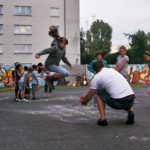Generation Games
Humanity’s cosmic passion. For generations
The grand finale is just 10 days away!

The grand finale of the Two Hours for Family campaign is just 10 days away! Czytaj więcej
Air Hockey

Requirements:
Any flat area
Time:
As long as we have coins
Participants:
2 people
Accessories:
3 coins, 2 lines or slats, drawing chalk
Game rules:
We draw on the ground a playground – a rectangle measuring approximately 100 cm x 70 cm and mark the gates on the opposite sides. 2 coins are our goalkeepers, the third smaller coin is a ball. We set it in the middle of the field and the players next to it. The starting player, holding the ruler in his hand, hits his coin – the footballer, in such a way that it reflects the coin – the ball. After his movement, the competitor’s turn follows. In such a cycle, players play until one of the players reaches the opponent’s goal. Goal scored is a point. After successful coin action – the ball returns to the starting position in the middle of the field. The game lasts to the previously determined number of points.
CIUPY

Requirements:
You can play anywhere at home, in the yard, at school, on a blanket, on a table, on the ground.
Time:
It depends on the number of players
Participants:
From 2 to….
Accessories:
5 small stones
Game rules:
The fun consists in tossing one stone up and simultaneously grabbing the rest from the ground and catching all in the palm of your hand. We spread stones on the floor. We choose one of them and keep it in our hands. We have to toss him up and at the same time pick up another of the spilled on the ground – we catch a stone lying on the ground so that we can catch the stone we tossed. We toss and catch with the same hand!
Having two stones in hand, we toss one of them and catch another (third) from the ground. Repeat the operation until we catch all five stones in one hand.
When we pass this stage, we start to catch in pairs. Spread four stones back on the ground and toss five up again. This time, however, while it is up, we only bring 2 stones from the ground closer to each other, grab the stone in the air. Only now, again, we throw a stone and collect two stones from the ground, we catch a thrown pebble. And again, one by one – we throw a stone, bring the other two stones nearer to each other, grab the stone.
Remember that all the time we keep in our hands all the pebbles and we throw away only one.
Then, similarly, we catch with threes and finally all four.
The last, most difficult stage is to throw out and catch rocks from the back of your hand: extend your hand, join and straighten your fingers, put stones on the back of your hand on the metacarpus, throw them all up, so as to catch them in the same hand.
If we do not catch, the next player takes the queue.
Hacky Sack

You can play Hacky Sack anywhere: at the bus stop, school corridor, and even at home. For several decades, this simple fun attracts with its availability and low budget requirements.
Requirements:
You can play anywhere in the house, in the yard, at school.
Time:
Until boredom or soreness
Participants:
From 1 to …
Accessories:
Hacky Sack – a rag ball filled with sand, pea or rice
Game rules:
You can play alone – practicing Hacky Sack.
From the top of the foot, we throw the ball up and we also catch the foot. If we have companions to play, we can compete in the competition “who will rise more times” or standing in a circle to reject the Hacky Sack to each other – so that it does not fall to the ground. The player who will not accept Hacky Sack, because he will fall to the ground, falls away (another version gets a penalty point). The winner is the one who is the last to stay in the circle (or has the least amount of penalty points).
If there are more players and space, you can arrange a pitch – mark two goals at opposite ends and raise Hacky Sack to the goal of the opponent to score a goal.
Rat

You can train yourself and agility in different ways. One of them was a rat.
Requirements:
Any flat area
Time:
As long as the legs last
Participants:
From 3 to a dozen participants
Accessories:
A long skipping rope, or two tied together, can also be a thick rope
Game rules:
One of the participants keeps the end of the skipping rope low above the ground and spins it rotating around its own axis. The other participants stand in a circle and jump over the rope. Whoever does not jump over, replaces the person from the inside and takes over the rope skipping.
Class

Requirements:
Pavement, asphalt, pitch, flat ground
Time:
It depends on how many participants are playing
Participants:
At least two, you can also train individually
Accessories:
Chalk for drawing on the pavement, or stick on the ground, throwing pebble
Game rules:
We draw the shape of classes on the ground. The game consists of going through eight classes.
The player throws a pebble on the first field – class, stands on one leg, jumps into the field, raises the pebble, jumps the rest of the fields and jumps out, thus trying to complete all eight squares. In the place where the classes are next to each other one jumps on both sides, both on the way to the destination and on the way back. The top jumps up, performs rotation in the air and jumps back. If the player tempts, the next person begins the queue.
The next round: we do not start from the beginning, but from the field where we failed.
„Skucha”/fail is throwing a pebble on an inadequate field, or on a rope, not losing one leg or snapping on a rope.
The winner is the one who first pops up the entire eight classes.
Caps

Requirements:
Hard surface
Time:
As long as the fingers last
Participants:
At least two players
Accessories:
Bottle caps, chalk or stick for drawing a track
Game rules:
Players first draw the track: chalk on the sidewalk or stick on compacted ground. The width of the track depends on the number of participants – the more, the wider the track must be. Mark the start line and finish line. The track can be complicated, full of turns, it can have obstacles from branches, stones, or puddles depending on the imagination and the possibilities of the participants.
The players set the caps on the grid, side by side, and flick the side of the cap sliding forward. They take turns changing and in this way they race to the finish line. Falling out of the track means queue loss. The one whose cap is the first to skip the finish line wins.

